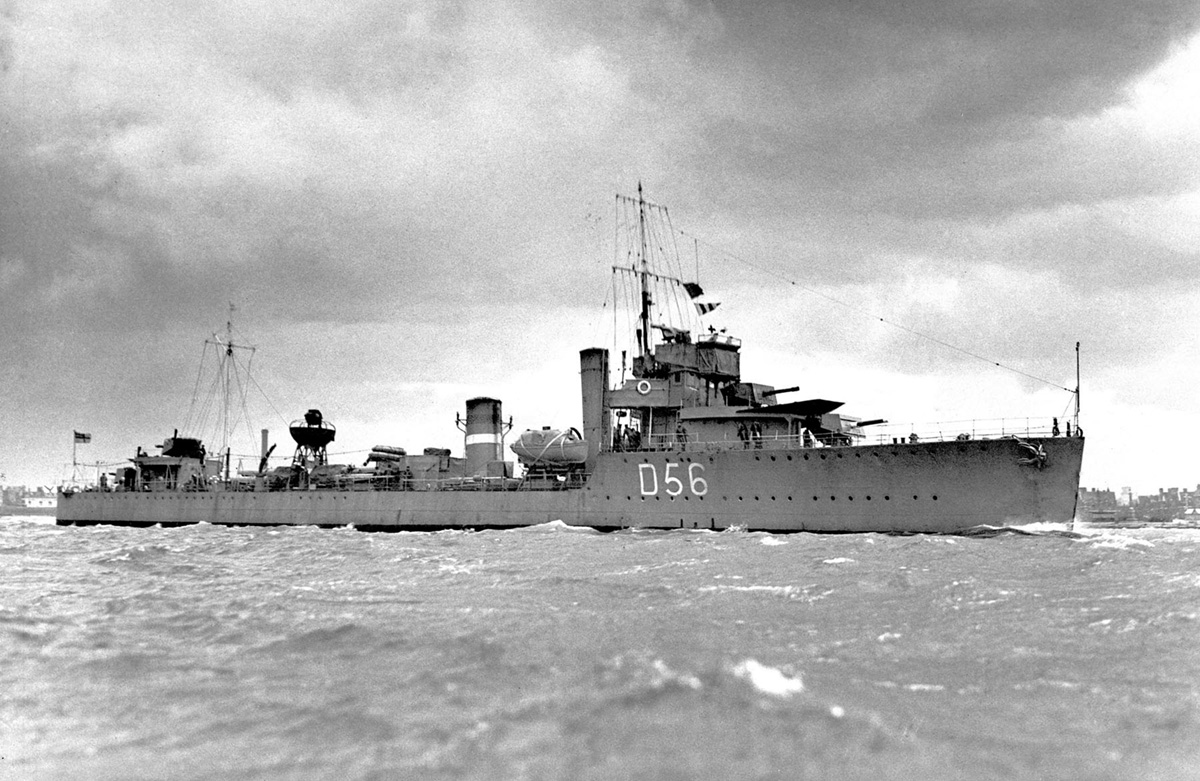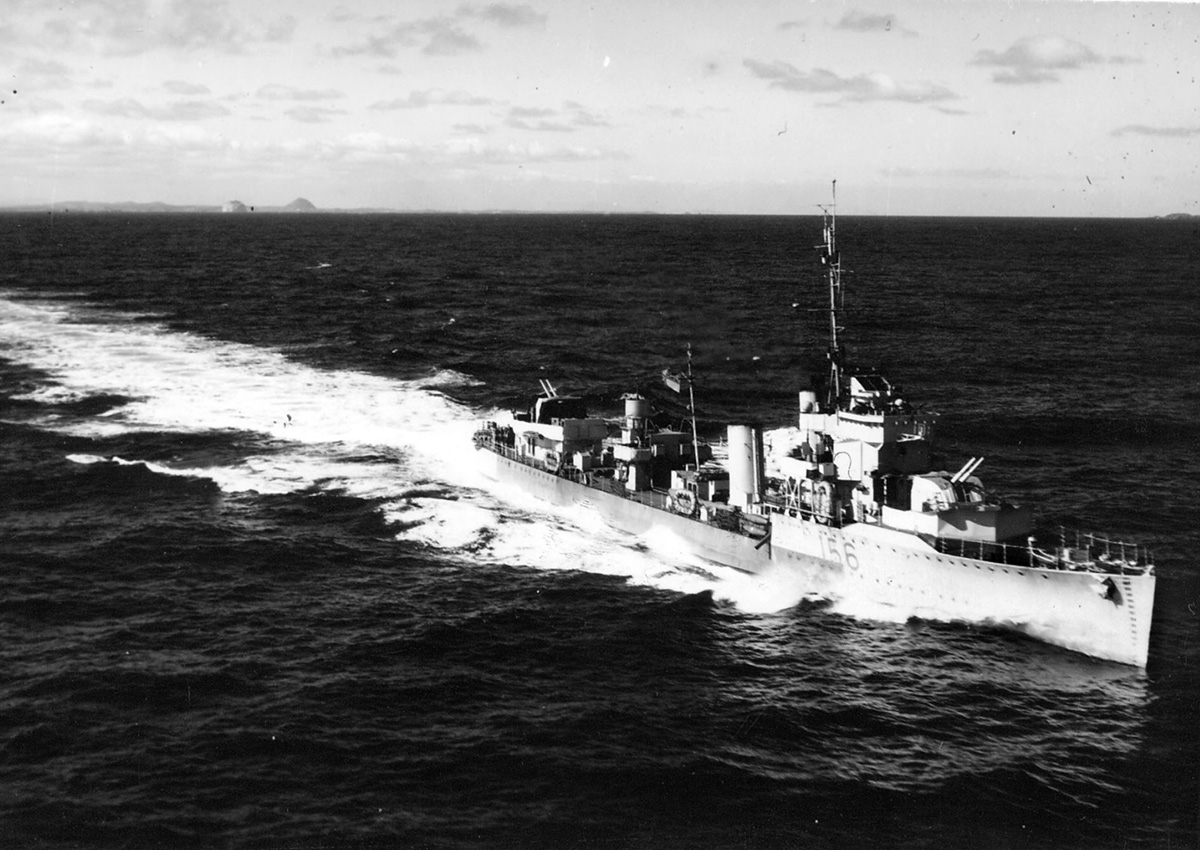
 HMS WOLFHOUND
HMS WOLFHOUND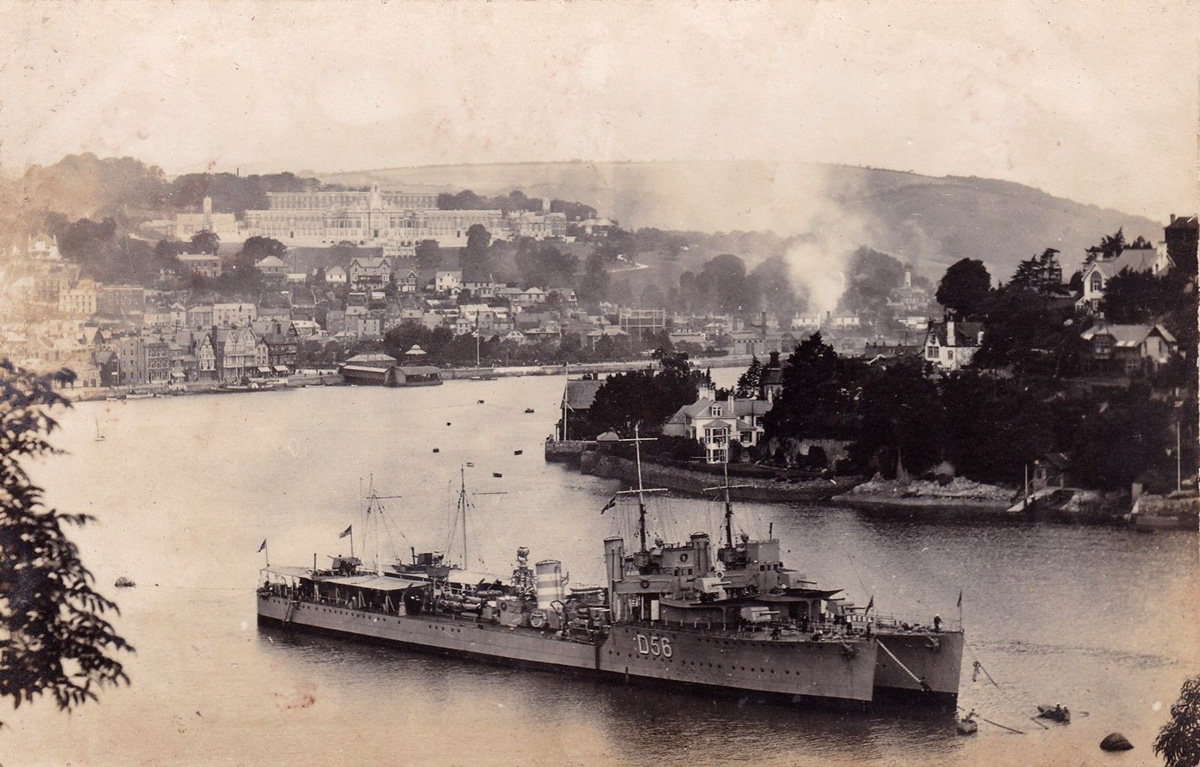
Click on the links within this brief
outline for first hand accounts by the men who served on HMS Wolfhound
HMS
Wolfhound was built at Govan
on the Clyde and completed in time to serve with
the Grand Fleet in the 13th Destroyer Flotilla in the final months of
the war. In 1921 she joined the 2nd Destroyer Flotillas as part of the
Atlantic Fleet and served in the Mediterranean but was put in Reserve
at Chatham.
In
1938 she was converted into an Anti-Aircraft Escort, a
WAIR conversion, her pennant number changed from D56 to I56, and she
joined the 1st Destroyer Flotilla at Portsmouth. Leading Seaman John Pearce described Wolfhound's role at Calais and Dunkirk in an online interview recorded by the IWM. On
Saturday 25 May 1940 HMS Wolfhound bombarded tanks on the approach roads to Calais, disembarked
ammunition for the troops, and returned with Vice
Admiral Somerville after he had told Brigadier Nicholson that Calais must be defended to the last. On Monday Wolfhound
took Captain William G. Tennant RN and a landing party of twelve
officers and 160 ratings to Dunkirk to direct operations to evacuate
the troops. She berthed
alongside the North Mole on a falling tide to disembark the landing
party, grounded and lost her port screw going astern to
get free. On that day Wolfhound
was the first destroyer to evacuate troops from the beaches but the
damage caused by grounding prevented her from taking any further part
in Operation Dynamo.
Commanding Officers
| Cdr John Cronin "Jack" Tovey, RN (April 1918 - June 1919) Lt Cdr William Leslie Graham Adams, RN (May 1933 - Feb 1935) Lt Cdr John Lee Machin, RN (Oct 1935 - Feb 1936) Lt Cdr Philip Lionel Saumarez, RN (May 1936 - Feb 1937) Lit Cdr Alfred C. Behague, RN (5 April, 1937 – 29 April, 1938) Lt Cdr Anthony F. Burnell-Nugent, RN (29 April, 1938 - 9 January 1939) Lit Cdr Charles G. N. Graham, RN (29 April 1938 – 4 September, 1939 |
Lt.Cdr. John Wentworth McCoy, RN (19 March 1940 - 21 July 1941) Lt.Cdr. James Arbouin Burnett, DSC, RN (21 July - late 1941) Lt. John Hubert Ackland Benians, DSC, RN (22 March 1943 - 16 Dec 1944) A/Lt.Cdr. Thomas Aitken Easton, RNVR (12 Dec 1944 - July 1945) |
Officers
This
short list of officers who served on HMS Wolfhound all
have entries on the unithistories.com web site. Further names from the
Navy List will be added later.
| Lt Edwin Peter Fitzmaurice Atkinson RN (Oct 1935 - Feb 1936) Lt Richard Hugh White Atkins, RN (August 1927 - June 1928) Lt John William Huyshe Bennett, RN (Dec 1936 - Feb 1937) Gnr George Brooks, RN (March - Dec 1943) Lt James Gerald Farrant, RN (August 1925 - July 1927) Lt Philip Henry Hadow, RN (April 1931 - Sept 1932) Lt John David Hope, RN (Jan 1945) Lt Michael Bryan Laing, RN (1923) |
Lt Horace Rochford Law, RN (May 1934 - July 1935) Lt Miles Mackereth, RNVR (April - July 1945) Surg Lt Arthur Thomas Marshall, RNVR (1944?) Lt Charles Alexander Meyer, RN (June 1934) Lt Robert G.B.O. Roe, RN (June 1936 - Feb 1937) 1st Lt Michael Sherwood, RNR (March 1943 - October 1944) Lt Charles John Skrine, RN (August 1930 - Feb 1931) Lt John Henry Wallace, RN (April 1931 - Sept 1932) |
Wartime Officers, 1939-45
This complete list of officers who served on HMS Wolfhound during the war has been extracted from the quarterly issues of the Navy List
| Lt D M D l’Anson RN (18 Mar 1940 – Oct 1941) Tp Sub Lt P G Bell RNVR (4 Apr 1945 - May 1945) Cmd Eng R Bowden RN (27 Oct 1937 – Feb 1941) Gnr G Brooks RN (16 Mar 1943 – Dec 1943) Mid C Carter RCN (Oct 1943 – early 1944) Tp Lt J D Davis RNVR (15 Feb 1943 – late 1944) Tp Sub Lt P S E M Dickens RNR (19 Jan 1945 - May 1945) Surg Lt H D Doyle RNVR (10 Apr 1943 – late 1943) Sub Lt R J Evans RNVR (28 Mar 1940 – Oct 1941) Tp Sub Lt P G Foote RNVR (4 Sep 1944 – May 1945) Sub Lt P R C Higham RN (23 Apr 1940 – Oct 1941) Lt John David Hope RN (Jan 1945 – Mar 1945) Indexed but not listed Tp Lt J B S Howard RNVR (12 Mar 1943 – May 1945) |
Tp Mid T E Jago RNVR (28 Aug 1944 - May 1945) Tp Lt P J D Jeffreys RNVR (Dec 1944 - May 1945) Tp A/Sub Lt T R Kennedy RNVR (29 Dec 1943 – May 1945) Act Gnr H W A Lester RN (30 Jan 1940 – Oct 41) Lt Miles Mackereth RNVR (Apr 1945 – Jul 1945) Surg Lt Arthur Thomas Marshall, RNVR (11 Apr 1940 – Oct 1941) Tp Sub Lt W J D Minogue RNZNVR (31 Mar 1943 – Mar 1945) Tp Sub Lt E H Owen RNVR (10 Apr 1943 – late 1944) Tp Lt (E ) AB Ritchie RNR (28 Dec 1943 – May 1945) Lt Michael Sherwood RNR (24 Mar 1943 - Mar 1945) First Lieut Lt H W Stowell RN (28 Mar 1940 – Oct 1941) Wt Eng J W Utting RN (29 Feb 1941 – Dec 1943) Mid M A Van Bergen RN (29 Nov 1940 – early 1941) Mid A J R Whitehead RN (14 Mar 1941 – Oct 1941) |
The men in HMS Wolfhound tell their stories
The Abdication of King Edward VIII
Lt Cdr Philip Lionel Saumarez, RN was the CO of HMS Wolfhound in December 1936 when she escorted escorted HMS Fury taking the Duke of Windsor across the Channel after the Abdication. Philip Saumarez
joined the cruiser Hawkins on the China Station as a Midshipman and was
one of the relief party ashore after the Shanghai
earthquake in 1923. Four years later he joined the submarine service
and served in L16, H32 and Oberon. He then turned to destroyers and
served in Boadicea during the Spanish civil war. The V&W destroyer Wolfhound was his first command.
John
Pearce was born at Manchester in 1918. His father
worked as a boilerman in a hospital and Pearce left school at 14 and
worked in a factory at Trafford Park before joining the Navy. When war was declared he was a
Boys Instructor at HMS Wildfire
in Kent. Captain Tudgeway assembled the boys, gave them the news and was cheered when he
ended his talk with "to Hell with every German!" They spent the
next two hours in shelters until the "All Clear" was declared.
In 1938
he was posted to HMS Whitley,
the first V & W to be given 4-inch anti-aircraft guns and was told
that
if war broke out she would defend London. They added ballast in the
bilges to make up the weight of the 4.7-inch guns removed. The
4-inch shells included their catridges and were raised on a cruet by a
hoist
to the gun crews, there was no need to assemble shells and catridge
before
loading. He was made Ship's Writer as he could type and was "clerk" to
Lt Bell, the Correspondence Officer.He had a hut as an office on the dockside at Chatham.
The CO, J.W. Bolwood (?), inspected the book in which he recorded
packages signed for by Lt Bell and found a book recording future ship
movements was missing. Lt Bell was court
martialled for the loss of the book andPearce was a witness.
Lt Bell was severely reprimanded but his officer "friend" proved that
the book could not have been received as it would not have fitted in
the size of envelope.
Calais
Pierce was posted to Wolfhound,
the "Guard Ship" at Calais, which bombarded tanks approaching along the
roads to Calais. He was
a LS Quartermaster on the searchlight platform and saw a bomb fall
down the funnel of a destroyer, HMS Wessex,
two miles offshore and it looked as if the whole ship had
been wiped out but the ship was not lost and most of the men were
saved. As Quartermaster he was in the wheelhouse when they
were alongside and the CO told
soldiers on the quayside they could not come aboard.
They returned to Dover and put a brow out to the foc'sle. Two
double decker buses arrived from Chatham with Capt Tennant's landing party of about
150, their first indication that they were to pick anybody up. He
directed them down to the iron deck near the torpedo tubes and returned
to Wheelhouse where his job was to steer the ship. It was a beautiful day,
everybody relaxing, smoking in the sun on the iron deck when they heard
the screaming noise of a Stuka dive bomber. They heeled to port and
there was chaos as they dashed to their action stations. They weren't hit but bombs fell on all side and they shot
down one of the three Stukas .
Dunkirk
Dunkirk was wreathed in black smoke. The jetty was
a long trestle wooden structure with a beacon light house at one end,
part of it broken off from the rest of the jetty. Bombs were falling
indiscrimately, soldiers diving into the water to escape the bombing
with their boots and uniforms. He thought Power, a tall commanding
figure was in charge of the landing party of "blue jacketts". They went
alongside the jetty, portside to. The gangway was higher on the jetty
than on the ship and a French civilian on the jetty was yelling out,
warning them that the tide was dropping rapidly and they would soon be
aground. The 1st Lt took them out astern but they lost or damaged their port screw
and tied up alongside a French trawler. They did not open fire on the
planes overhead, perhaps not to attract attention to themselves. The CO
came aboard, they again went out stern first and headed out to sea.
Taking men off the Beaches
Pearce was told to report to the CO, Lt Cdr J.W. McCoy RN, on the
bridge and was ordered to take the motor boat to a beach in front of a
gas holder which was on fire to pick up refugees. He had no idea they
were there to evacuate the troops. It was part of his
job as Quartermaster to drive the motor boat; he took the tiller and communicated by
whistle with the the "tankie" a two badge
AB who was in charge of the engine, and they towed the whaler with
an AB aboard with a rifle. It was about 2 - 3 pm, there were no
refugees on the
beach, but a few soldiers with one wounded eventually turned up. He
waited half an hour
but nobody else came so they made their way back to their ship, the
only ship waiting offshore. He was ordered back to the beach,
nobody was there for some time but eventually he managed to fill their
boat, taking
aboard 30 - 40 troops, mostly in the whaler. A calm beautiful day, a
scrambling net was lowered so that the troops could climb aboard the Wolfhound.
More troops arrived on the beach, and Pearce was ordered back in the
whaler to bring them out to the ship. Drifters and smaller crafts
arrived close inshore and he took the troops to them so that he could complete more
trips. He made between a dozen and twenty trips. He returned to Wolfhound
for instructions and was told to tow six lifeboats from a liner lying
further out to the beach and return them afterwards to the liner. The sea
was crowded but there was no bombing of the beach and he could cope
with the numbers on the beach. The sea was now quite crowded and he could only tow three of the lifeboats back to the
liner. It was now dark and they left a phosphorescent wake and he was worried that this might be seen by enemy aircraft.
He returned to Wolfhound and was told they would be hoisted aboard, as the drifters taking troops to Wolfhound were full.
It was 2 am and he had not eaten since 2 pm but
had to organise the lifting and stowing of the boats himself. He went
down to the Mess Deck for tea but the stench was dreadful,
choc-a-block
with soldiers, so he went back to the wheelhouse without a cup of tea
and Wolfhound made her way back to Dover. The missing screw affected
the
steering and she needed 15 degrees on to counter this. They were
attacked
on the way back, a plane firing tracer bullets. Thry arrived very early that morning. The troops left the
ship, leaving utter chaos behind, souvenirs, letters, tin helmets and
even wallets. Five people had died in the messroom on the way over. Opened deadlights
and port holes to let in fresh air and cleaned the ship from top to
bottom. They went back to Chatham but had to give priority to another
destroyer, the Isis or Inglefield,
one of the I Boats.
Back home in Sheerness
He returned in civilian clothes to his home in Sheerness at dawn and felt embarrassed to be seen in civies as the troops were arriving. He was shocked to see first hand how bad things were. His wife was expecting a baby and he thought the Germans might soon be invading Britain.
The IWM also has an interview with Jack Sharp, a signalman in HMS Ivanhoe and Wolfhound
during Dunkirk evacuation (28 May - 4 June 1940) recorded by BBC Radio
Kent but for copyright reasons this recording is not available online
and can only be heard at the IWM by prior arrangements.
From June 1940 onwards Wolfhound was mostly on East Coast convoys. On the 3rd September 1941 she was attacked by JU-88 aircraft while escorting FS.84. A near miss forward caused severe damage and the forward part of the ship broke away and sank near the southern end of the Dudgeon Shoal, fifteen miles off the Norfolk coast. The remaining part was taken in tow and was berthed at Immingham on the 4th September. She was eventually repaired and re-commissioned on 31st March 1943, but her condition was such that she could no longer take part in any major action.
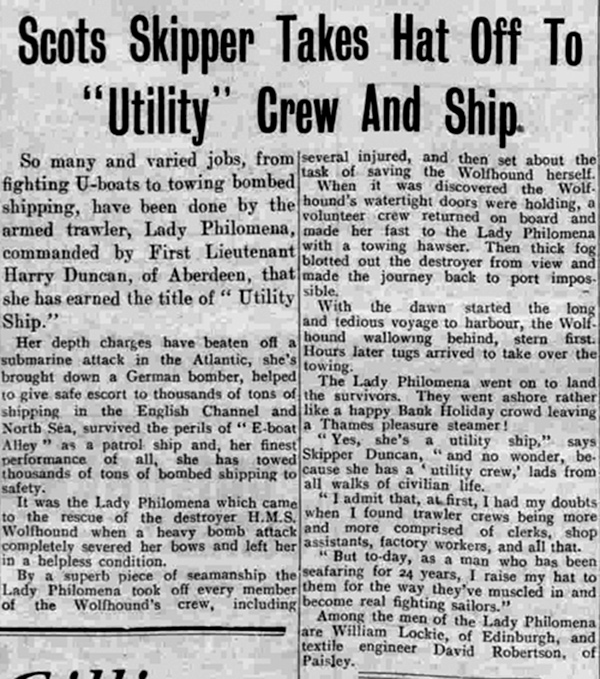 The more detailed account published in the Sunday Post.
Both articles were based on
the same press release issued when Wolfhound returned to active service after nearly two years in the naval dockyard under repair.
|
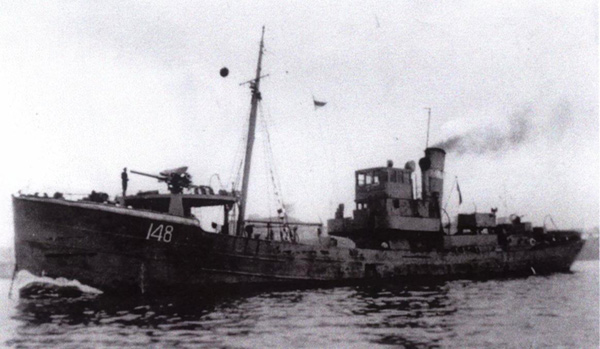 Bad news was not reported in the press but on the 27 August 1943 this brief item was published in the Hull Daily Mail after Wolfhound returned to service: "In September 1941 HMT Lady Philomena (above) rescued crew members off the HMS Wolfhound
after she had been badly damaged by an enemy bomber. The fore part of
the vessel was torn away from the bulkheads, but the after part
remained afloat. The Lady Philomena
steamed towards her and took off 150 of the crew, then stood by in a
thick fog for six hours and managed to take the remaining half of the
destroyer in tow. By excellent seamanship, Skipper Lieut Robinson was
able to bring the damaged vessel to port, and later it was repaired and
was able to be put into commission again. Robinson was mentioned in
despatches for this."
|
The Lady Philomena was a Hull trawler requisitioned for use as an escort with naval officers in command. She had taken part in the evacuation of troops from Dunkirk but was mainly used as an escort for east coast convoys, usually as an "additional escort for E-Boat Alley", the area extending from Cromer to Harwich which was within range of the E-Boats.
Len Wadsworth's story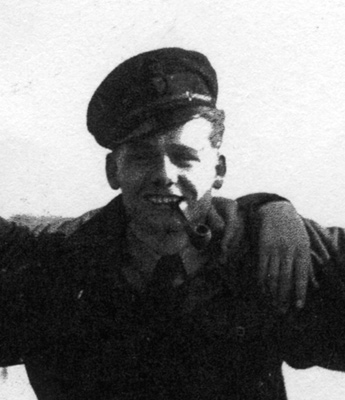
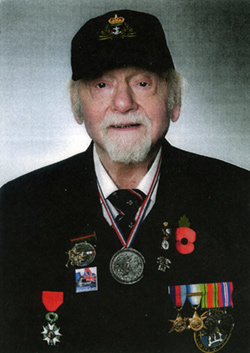
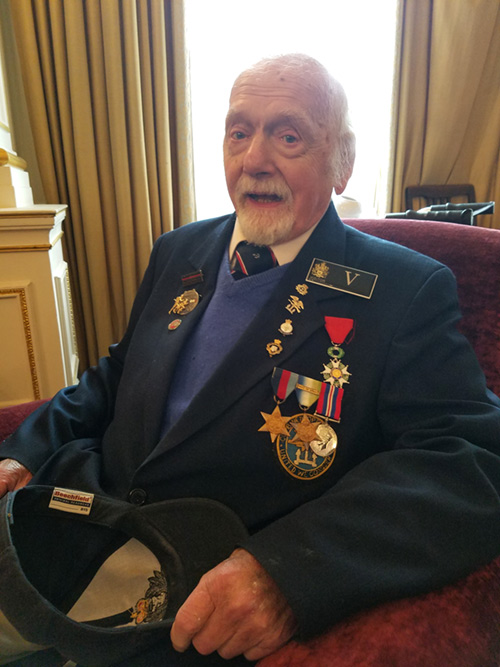 Liberating Norway
Liberating Norway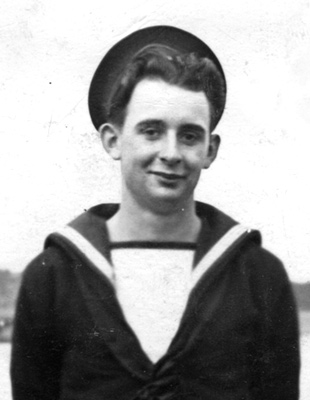 |
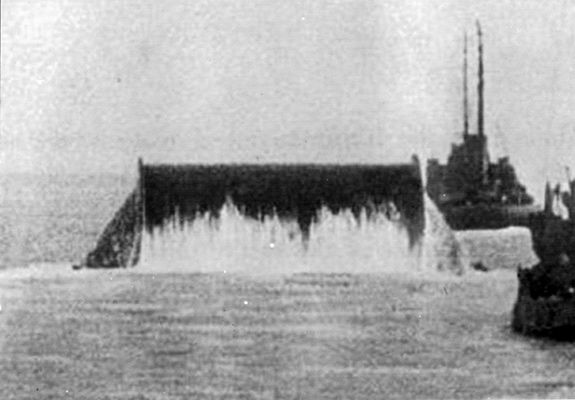 |
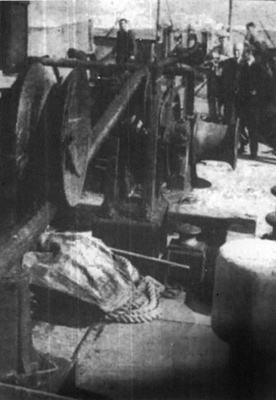 |
Bustler
was a 3,200 HP Admiralty Rescue Tug engaged in the laying of the PLUTO "pipeline under the ocean" which
carried oil across the seabed beneath the English Channel to the
Normandy beaches to fuel the tanks and vehicles advancing from the
beach head against German forces.
Bustlertowed the huge 30 foot diameter revolving drum known as a conundrum (or conum) round which the HAMEL steel pipe was wound. As the conum spun in the water the pipeline uncoiled (see centre above). A smaller tug followed behind to facilitate the steering of the revolving drum. Fred Gillheard was interviewed at Sheerness about PLUTO by Dan Snow for his "One Programme" but the family's recording of the broadcast was lost in a fire after his death.
From Tug to Battleship
In July 1944 Fred was posted from an Admiralty tug to the battleship, HMS Malaya, from one extreme to the other. In August 1944 HMS Malaya had
been "Paid off into Reserve at Faslane because of her machinery
state which limited capability for Fleet operations". Her last mission
in July 1943 had been an operation off the Norwegian coast to divert
attention from the imminent landings in Sicily. Fred Gilleard
joined her at Portsmouth where she "had been recommissioned for
bombardment duty".
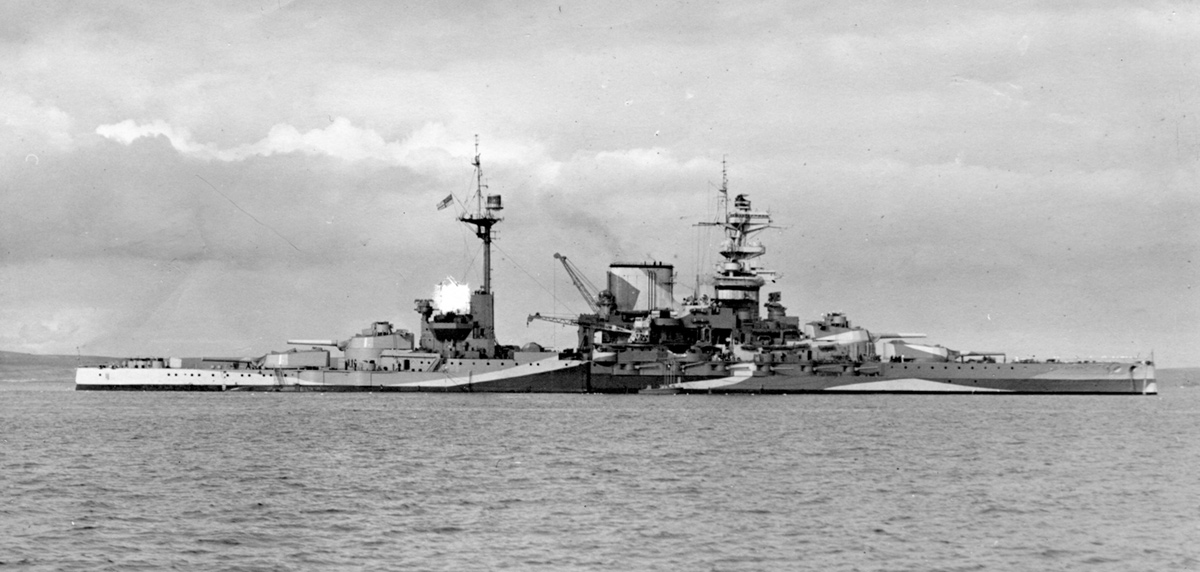
Although no longer a fighting ship her guns made a splendid backdrop for this photographs of Fred and his shipmates ("passed by censor 7/9/44"):
(1) K.S. Brown (Chief Groom), (2) H. Spiers, (3) M. Symnott, (4) Charles V. Craels, (5) R. Hendley, (6) Fred Gilleard, (7) Brinley J. ?, (8) Arthur B. Kirby (Stable Lad), (9) B. Saullt (Baldy), (10) R. Wilson, (11) James Kelly, (12) R.D. Dixon, (13) William Cree, (14) J.K. Weston (Boss to Trainer), (15) L. Johnson (Rat Catcher).
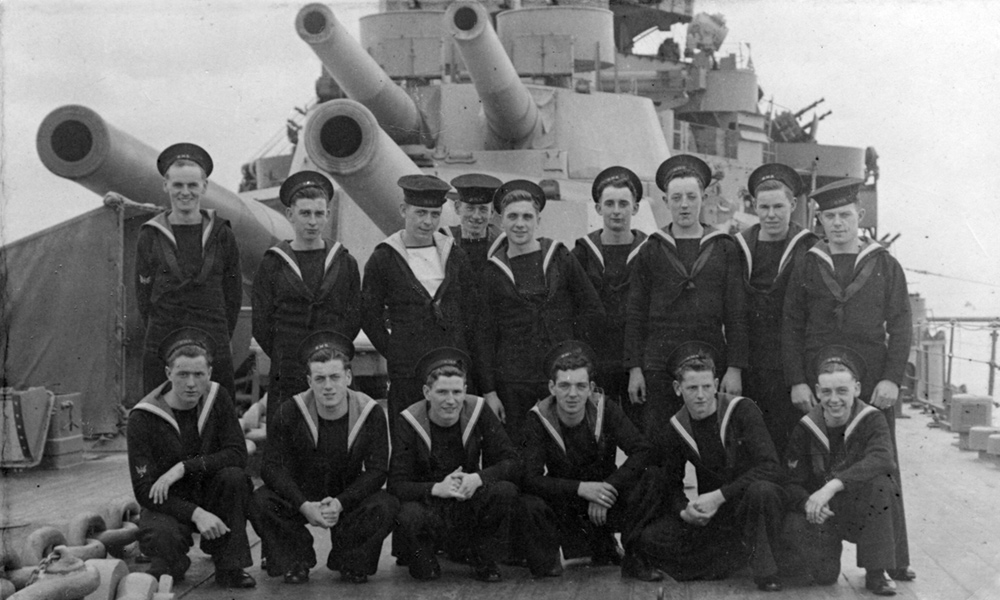 |
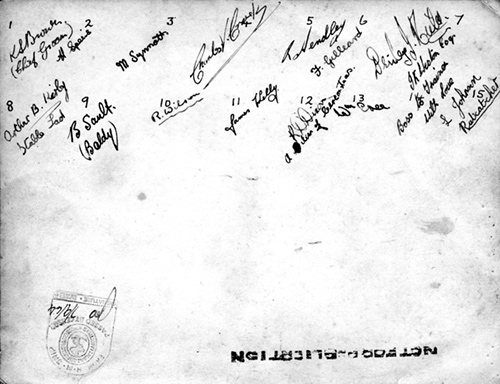 |
Liberating Norway
In October Fred joined HMS Wolfhound and in May 1945 Wolfhound was one of the destroyers which "liberated" Norway. The aerial photograph below was taken from an aircraft based at RNAS Donibristle three miles east of Rosyth on the 24 April 1945. The war ended on the 8 May and Wolfhound was one of the destroyers of the Rosyth Escort Force sent to the ports of entry on the West Coast of Norway to accept the surrender of German naval forces. Wolfhound was sent to Bergen and Stavanger as described by Peter Scott (above) and photographed by Fred Gillead.
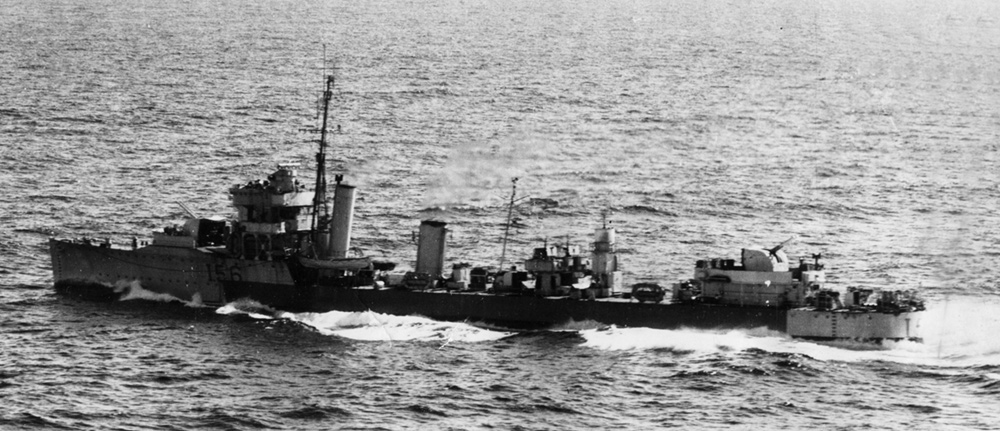
This aerial photograph was taken from an aircraft based at RNAS Donibristle three miles east of Rosyth on the 24 April 1945
Courtesy of Susan Parsons
